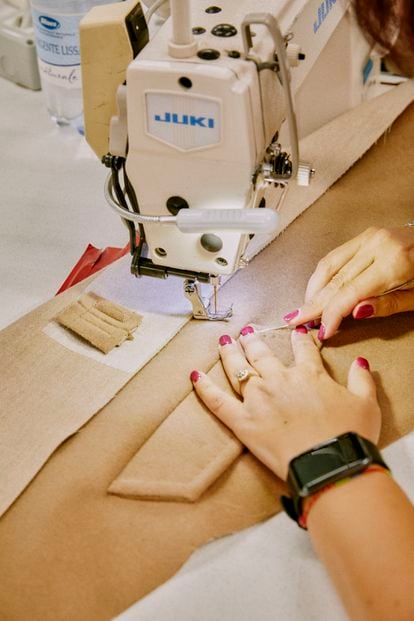Reggio Emilia, the small town in northern Italy between Parma and Bologna, known for Parmesan cheese reggiano, hides some secrets. In the Panizzi library, in the historic center, a classic image: a man unfolds the pink pages of La Gazzetta dello Sport; Inside, college students study in the main room, under green glass desk lamps. Looking up, a huge geometric painting by Sol LeWitt adorns the ceiling, built in 1798. The American artist's intervention was a gift to the city from the Max Mara group, Reggio Emilia's second textile treasure. The first was the tricolor flag, which today represents Italy and was created in this city.

In another garden, in another area of the city, Maria Giulia Prezioso Maramotti is waiting for dinner. There is Parmesan cheese on the table, of course, but also cappeletti, a traditional meat pasta from the area that Maria Giulia, granddaughter of Achille Maramotti, founder of Max Mara, encourages you to try. The director of retail of the company remembers his childhood in Reggio Emilia when he played on the carpet of his office in the first Max Mara factory on Via Fratelli Cervi: “His secretary didn't want to let us children in, but he liked it and we went in and played on the ground between the smoke of his cigar.” In that factory founded in 1957, he crystallized an idea that Maramotti had in 1951: to create quality clothing, with bold designs, for the middle class, and make it industrially at affordable prices. On the floor of the old building you can still see the traces of the enormous sewing and cutting machines that occupied the floors that today house the Collezione Maramotti, started in the sixties by Dr. Maramotti. The selection is eclectic: there are international artists such as Alex Katz or Anselm Kiefer, but it all started with Italian art. The representation of pop art, arte povera, trans-avant-garde and Italian minimalism is surprising for its bravery. “It is the exhibition of his own taste. My grandfather always acquired contemporary art from his time, emerging artists with whom he became good friends, like Pistoletto or Parmeggiani, and that spirit remains. In 2002 we established the award with the Whitechapel gallery in London Max Mara For Women for an artist under 40 years old.”

Preserving the legacy of Achille Maramotti is not the only goal of the family that still leads the group that owns Max Mara, Sportmax, Max Mara Weekend, Marina Rinaldi, Marella and Max & Co. Another of its goals is to give back to Reggio Emilia—Reggio they call it in the group's offices—everything that this agricultural city in the heart of industrial Italy has given it. That is why the collection can be visited four days a week for free. And that is also why the group does not move from the city where it created the flagship piece of silent luxury: the 101801 coat. It left its workshops in the eighties and is still made in the Manifatture of San Maurizio: 10,000 square meters, about 240 people and 12,000 pieces being made at the same time result in 350 coats a day. From cutting to making, each piece of fabric passes through expert hands and specific machines (the puntino, that seam that finishes their coats, is the result of a rough-looking machine with manual manipulation that they invented and patented), until the coat in question, which is then ironed and prepared. A QR allows you to follow each piece through the factory.
There, under the natural light of the skylights, you can see the workmanship of 101801, but also the remnants of the Teddy stuffed animal, the coat created in 2013 that is experiencing a golden age for being the favorite of celebrities like Julia Roberts or Haley Bieber. Not everything is camel, there are also scraps of red wool, perhaps to satisfy the hunger of power coats which Nancy Pelosi culminated in 2018 with her then-discontinued red Max Mara that she wore when leaving a tense meeting with Donald Trump and that she already used at Barack Obama's inauguration.

Coats are the center around which the Italian house pivots, which with all its brands has a turnover of almost 1.8 billion euros a year. In the Max Mara archive, guarded by its creator, Laura Lusuardi, all the models can be seen together. Lusuardi, fashion director of Max Mara, began working with Achille Maramotti in 1965. A guardian of the essences of the brand that was created to dress the doctor's wife, a phrase they use almost like a slogan. But to dress the bourgeoisie requires a lot of knowledge and so Lusuardi started an archive during Maramotti's lifetime, with which she traveled to acquire some pieces. The archive is located in a 1910 building that occupies 4,000 square meters where some 8,000 garments from designers such as Cristóbal Balenciaga, Chanel, Madame Grès, Comme des Garçons and Thierry Mugler, vintage pieces, work clothes, as well as 20,000 garments from the group's brands in a study of the history of fashion and clothing unprecedented for a brand. The archive is not public, but students and fashion curators come to it. Franca Sozzani and Carine Roitfeld have donated part of their private collections to the archive. Lusuardi drives his car from the archive, which he has shown almost piece by piece with an unfathomable passion, to the Max Mara headquarters, also in Reggio, a glass complex separated by gardens and ponds where they have a library of fashion publications ranging from books by Spanish photographer José Ortiz Echagüe to the latest issue of Love magazine. Lusuardi drives fast and with determination, this is Reggio, a quiet place, but we are in Italy. A few kilometers from here Enzo Ferrari was born and Maserati was created. I ask Lusuardi if he ever wanted to leave Reggio. Never, she says
#Max #Mara39s #famous #camel #coat #aspirational #world